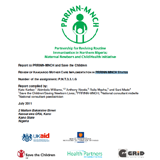
Nigeria’s PRRINN/MNCH Programme began training trainers in Kangaroo Mother Care (KMC) in 2009 from 3 target states (Katsina, Yobe and Zamfara). As of July 2011, 31 master trainers have carried out both on-site and off-site step down KMC training to over 150 health care providers. Health care facilities were provided with KMC kits for own facility-based usage. PRRINN-MNCH has provided KMC training to 22 health facilities in target states as well as commodities (KMC kit comprising a wrap, cup and spoon, nappy) and equipment (weighing scale, ambubag and mask) to enable KMC implementation.
Between 24-31 July 2011 a team of 4 staff visited 20 health facilities in Yobe, Katsina and Zamfara states in order to assess the implementation status for Kangaroo Mother Care (KMC) in these facilities. The sites were assessed using a standard methodology and questionnaire tool for monitoring the progress of KMC implementation that had been developed and tested by the South African Medical Research Council Research Unit for Maternal and Infant Health Care Strategies.1 Each site receives a total score out of 30 based on three phases: pre-implementation, implementation and institutionalisation.
Six sites (2 training facilities, 2 CEOC, 2 BEOC) were identified as demonstrating evidence of routine and integrated KMC; nine facilities (2 CEOC, 5 BEOC, 2 PHC) demonstrated evidence of practice; five facilities (1 CEOC, 3 BEOC, 1 PHC) were in the process of taking ownership of KMC; and one PHC was in the adopting the concept stage.
Overall, staff appeared well-trained and enthusiastic about KMC and space was available for KMC practice. However, facility utilisation was very low and there was little demand for inpatient facility-based care services. The quality of recording was highly variable across sites. None of the sites had KMC-specific job aids or guidelines in place to guide KMC practice. Below are specific recommendations for key stakeholder groups involved in KMC implementation:
Recommendations for PRRINN-MNCH
- Create a simple poster for Kangaroo Mother Care that can be displayed in health facilities in order to encourage KMC practice by both mothers and health workers
- Follow up on KMC register completion during routine supervision visits.
- Consider training on collecting and using data for senior staff at health facilities.
- Link with PO-Demand to ensure that community engagement personnel counsel families and pregnant women on newborn health messages including KMC, and identify and refer small babies. Consider using and testing the foot size job aid developed in East Africa to assist in identification of small babies at community level (see Appendix 4.14).
- Circulate a proposed curriculum for orienting new staff on KMC. A one day on-site training curriculum which includes a clinical and practical component is found in Appendix 4.10. On-site orientation can also be done incrementally, e.g. 1 hour per day for one week.
- Introduce a job aid/checklist for facility staff to follow when starting KMC, discharging from KMC and during follow-up visits (Appendices 4.11-4.12).
- Consider simplifying newborn job aids and reducing the technical language since many of the frontline staff at these facilities are lower level cadres with English as a second language. In the interim, orient service providers on the existing job aids.
- Replenish the current supply of KMC wraps while encouraging facilities to seek innovative ways of resupplying the material (e.g. having women bring in fabric and asking the facility administration for a small amount of funds for sewing).
Recommendations for health facilities
- Improve linkages between labour, maternity and OPD so that preterm babies are quickly identified and admitted to KMC.
- Encourage breastfeeding every 2 hours for babies weighing less than 1.5kg and every 3 hours for those weighing more than 1.5kg. Record the frequency of breastfeeding and the amount (for those using expressed breastmilk) in the patient notes.
- Weigh babies at least once per day and record this information in the patient notes.
- Include weight on admission to KMC and weight at discharge to the standard register.
- Include neonatal deaths and KMC as indicators in the monthly summary wall charts.
- Present KMC statistics at regular Ward Development Committee meetings. Consider inviting a mother and baby who have “graduated” from KMC to demonstrate the effectiveness of the intervention.
- Use standard checklists for admission, discharge, and follow-up for KMC, as well as orientation for new staff to ensure all key messages are covered.
Recommendations for training instructors
- Provide extra hands-on time with equipment (thermometer, weighing scale) during KMC training to ensure staff know how to use the equipment.
- Review the training manual sections on breastfeeding and remove all references to feeding “on demand.” Low birthweight babies n KMC should be fed every 2-3 hours.
- Show participants how they can use traditional fabric to secure babies in KMC in case mothers do not have a special KMC wrap.
- Focus on the importance of register completion and monitoring and evaluation.
- Add a checklist for admission, discharge and follow-up to the counselling section of the training.
Recommendations for Save the Children
- Consider integrating KMC messages into health education at ITP sites.
- Request review IYCF, particularly to review the breastfeeding section of the KMC training manual.